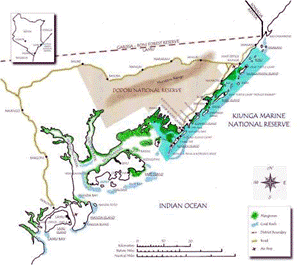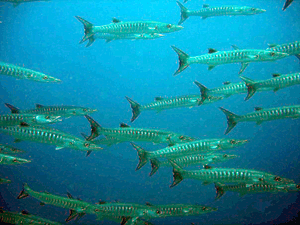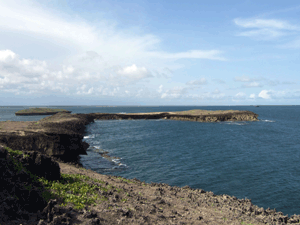Coral Bleaching Response and Monitoring in the Kiunga Marine National Reserve
Location
Kiunga, Kenya, Western Indian Ocean

Kiunga Marine Project map. Photo © World Wildlife Fund/Kenya Wildlife Service
The challenge
Kiunga Marine National Reserve (KMNR) is located at the northernmost stretch of the Kenyan coastline at the confluence of two major ocean currents (the north-flowing East African coastal current and the south-flowing Somali current), which creates nutrient-rich upwelling. The reserve covers 250km2 and provides a refuge for sea turtles and dugongs. The coral reefs found within KMNR are comprised of mainly patch reefs, with fringing reef in the northern part. Seagrass beds form the most extensive wildlife habitat in the KMNR. Mangroves also provide critical habitat for various species, serving as forage and resting areas for sea turtles and nursery grounds for juvenile fishes. These mangrove-dominated environments equate to approximately 30% – 40% of Kenya’s mangrove stock.
The primary goal of the reserve is to safeguard the biodiversity and integrity of physical and ecological processes of KMNR, for the health, welfare, enjoyment and inspiration of present and future generations. Although resilience principles were not initially taken into consideration during the design of the reserve in 1979, they have since played a major role in the management of the reserve. The 1998 mass bleaching event triggered interest in the effects of climate change, and subsequently resilience principles were incorporated into the management plan.

Barracudas. Photo © Gabriel Grimsditch
Climate change, El Niño Southern Oscillation (ENSO) related events, and overfishing are a threat to this area. Kiunga reefs are ecologically marginal due to a natural barrier provided by major rivers separating them from other Kenyan reefs, and to the influence of high nutrients from upwelling off Somalia. The Kiunga reef system has not recovered from the 1998 bleaching event as quickly as other reefs along the Kenyan coast.
Numerous factors have made management of the reserve challenging. Due to the area’s proximity to the Somali border, it is difficult to enforce management schemes and patrol the area. The local community does not have a strong appreciation for sustainable resource exploitation in an area of constant lawlessness. The World Wildlife Fund (WWF) and Kenya Wildlife Service (KWS) are working to promote environmental education and awareness programs that co-manage natural resources with the local community. The area’s remoteness also makes management challenging because of logistics, high operational costs, and the difficulty of recruiting and retaining skilled and dedicated personnel.

Kiunga Marine National Reserve. Photo © Gabriel Grimsditch
Actions taken
To address the issues of management capacity, WWF and KWS have partnered with conservation and research organizations to carry out regular monitoring to both share costs and attract expertise. With the assistance of partners, the goal has been to reduce impacts (such as fishing) by encouraging sustainable gear and practices, thus improving the reefs ability to withstand natural disturbances.
Currently, coral reef resilience monitoring is being implemented due to the development of an International Union for Conservation of Nature (IUCN) methodology. In 1998, the ENSO-related bleaching event generated a partnership between Coastal Oceans Research and Development in the Indian Ocean (CORDIO) East Africa, United Nations Environment Programme (UNEP), Kenya Marine and Fisheries Research Institute (KMFRI), and Kenya Wildlife Service (KWS) for monitoring. These partners focused on monitoring bleaching (using a Global Coral Reef Monitoring Network methodology), while a wider team of 20 local fishermen monitored other coral reef ecological indicators such as fish, invertebrate and benthic populations, as well as the use of fishing gear. In 2006, a monitoring partnership with KWS began monitoring coral disease. In 2008, monitoring of coral reef resilience began in partnership with IUCN, CORDIO and KWS. Indicators that are being monitored include coral size class, herbivorous fish populations, coral condition and other wider resilience indicators such as oceanographic, anthropogenic and ecological factors. These various monitoring programs have guided management interventions by forming the benchmark for a zoning plan, and by enhancing co-management of natural resources due to increased participation and knowledge of fishermen in the region.
How successful has it been?
The integration of resilience principles in the management of the KMNR has improved management of resources due to increased knowledge of the reserve and its resources. Additionally, co-management has been enhanced and relationships with the local community have improved. Lastly, the level of awareness of coral reef conservation within the local fishing communities has increased. This has changed the attitude of fishermen, who now recognize the importance of conserving their environment for the future and are now less likely to use destructive fishing gear.
Lessons learned and recommendations
- Functional partnerships between government agencies and NGOs are critical for effective management and cost reduction.
- Community buy-in is critical to establishing resource ownership and raising awareness/knowledge of environmental/climate change issues within the local community.
- It is recommended that resilience studies and principles be understood and communicated among scientists, resource managers, and resource users.
- It is critical to reduce the human impacts on reserves to provide a foundation for resource managers to better mitigate against the impacts of climate change.
- Raising the profile of climate change is critical so that managers can help the community understand the real and present threat to natural resources.
- Working to increase community understanding of the importance of taking a resilience-based approach to management is critical to management success.
Funding summary
MacArthur Foundation
United States Agency for International Development (USAID-GCP)
Swedish International Development Cooperation Agency (SIDA)
United Nations Environment Program (UNEP)
World Wildlife Fund (WWF)
Lead organizations
WWF Regional Office for Africa
Coastal Oceans Research and Development – Indian Ocean East Africa (CORDIO)
Partners
Kenya Wildlife Service (KWS)
Kenya Marine and Fisheries Research Institute (KMFRI)
Kenya Department of Fisheries
CORDIO
International Union for Conservation of Nature (IUCN)
UNEP
WWF
Resources
Kiunga Marine National Reserve
Natural resource dependence, livelihoods and development: Perceptions from Kiunga, Kenya




